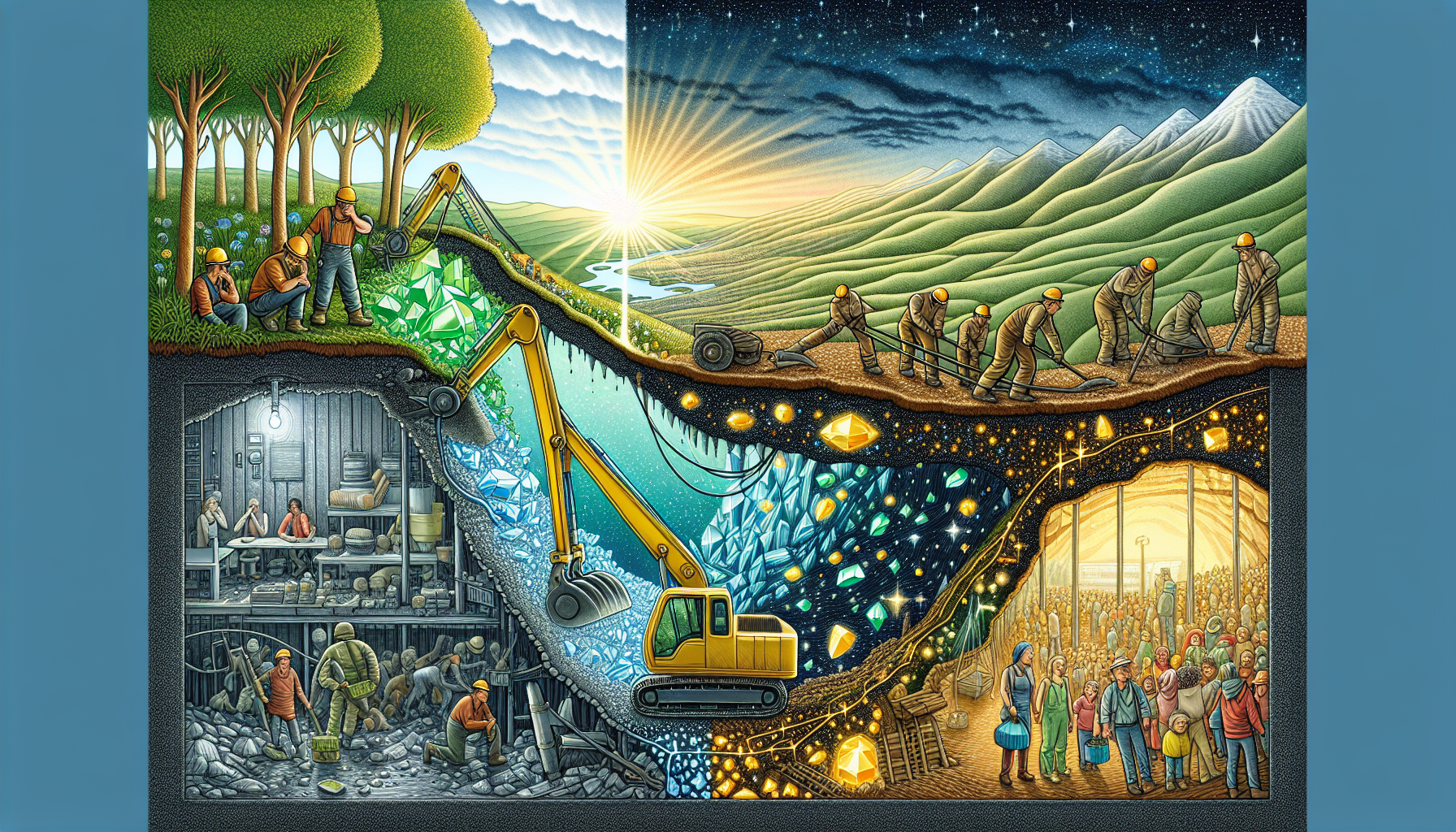The road to a sustainable future will need to be paved with precious metals. But what defines sustainable mining and how is it achievable? Delve into the core of responsible resource extraction as we explore the convergence of advanced technologies, stringent regulations, and proactive community engagement that outline a future for the mining sector focused on sustainability. This comprehensive guide offers insights into the real-world applications of sustainable mining practices, shedding light on how companies are navigating the challenges to protect both people and the planet.
An industry with the potential to be the leaders in the transition to a sustainable future.
Key Takeaways
- Sustainable mining practices are founded on three core pillars: environmental stewardship, community engagement, and economic resilience, aimed at ensuring the industry’s activities contribute positively to both environmental sustainability and social welfare.
- Technological advances in the mining industry, such as the use of renewable energy, autonomous vehicles, and IoT, are improving safety and efficiency, leading to reduced environmental impact and paving the way towards more sustainable operations.
- Global initiatives and regulations, such as the Initiative for Responsible Mining Assurance (IRMA) and adherence to United Nations Sustainable Development Goals (SDGs), demonstrate the mining industry’s commitment to responsible mining and the integral role it plays in global sustainability efforts.
Understanding Sustainable Mining

Sustainable mining is not merely a catchphrase; it’s a multifaceted approach that harmonizes mineral extraction with environmental care and social responsibility. It’s the industry’s response to the escalating demand for raw materials. It is driven by a century of intense resource extraction that has placed an immense strain on the planet’s natural resources and on the communities it was meant to serve. This approach goes beyond the mere act of mining, encompassing the fundamental needs of communities—clean water, food, employment—and aligning the financial success of mining activities with a conscientious regard for the environment and society.
Mining companies across the globe are awakening to the pivotal role they play in steering us toward a sustainable future. After all, we cannot get to a sustainable future without the use of precious metals. These include: gold, silver, platinum, palladium, rhodium, iridium, osmium, rhenium, and ruthenium. By investing in efficient technologies and measuring their environmental impact against globally accepted frameworks, these entities are not just extracting minerals; they are crafting a sustainable mining plan that promises to fulfill today’s needs without compromising tomorrow’s dreams.
The Pillars of Sustainable Mining Practices

The bedrock of sustainable mining practices is founded on three pivotal pillars—environmental stewardship, community engagement, and economic resilience. Each pillar is a testament to the mining industry’s evolving ethos. They ensure that activities do not just extract value from the ground but also sow seeds for a greener, more equitable future.
These pillars are not standalone silos; they intertwine and reinforce each other, creating a robust framework for the mining sector to operate within the realms of sustainable development. Read on for the strategies and innovations that are making a tangible difference.
Stewarding Natural Resources
At the heart of environmental stewardship in mining is the conscientious management of natural resources. Water, an essential component of mining operations, is treated with the utmost respect. Technologies for water reclamation are increasingly being adopted to significantly reduce freshwater consumption. This is the first critical step for the sustainability of mining and the natural environment. Furthermore, by optimizing technology investments in the mine water treatment cycle, sustainable miners are able to lower their consumption of reagents. This is particularly relevant in gold mining, thus minimizing the environmental & carbon footprints of their activities.
Land rehabilitation is another cornerstone of responsible resource management. Sustainable miners understand that their duty extends beyond extraction. They must see themselves as custodians of the land. As such, they engage in the practice of returning mined lands to their natural state or pre-defined post-mining use. This ensures that the environmental performance of mine sites are maintained or even enhanced after mining activities have ceased.
Engaging with Local Communities
Sustainable mining recognizes that local communities are not merely neighbors but partners in the journey towards sustainable development. Engaging these communities involves forming collaborative partnerships that honor their rights and cultural heritage. The Community of Interest Advisory Panel plays a pivotal role in this engagement, ensuring that mining initiatives resonate with a variety of stakeholders, including:
- Aboriginal groups
- Environmental NGOs
- Labor organizations
- Financial entities
The inclusion of diverse perspectives is instrumental in achieving long-term benefits for the local economy and fostering social development. Sustainable mining practices drive investments in infrastructure, education, and community development. In turn this creates a harmonious relationship between mining companies and the communities they serve. This symbiotic connection paves the way for sustainable economic growth and social harmony. By utilizing best practices, it reflects the mining sector’s commitment to social responsibility and environmental stewardship. It also creates transparency which in turn builds trust with the stakeholders.
Achieving Economic Sustainability
Economic sustainability is the final pillar, ensuring that the fruits of mining are not just immediate but long-lasting. With the mining industry’s significant contribution to revenue and the nonrenewable nature of mineral resources, efficient use of resources is imperative. Strategic actions are necessary to secure the mineral supply needed for a clean energy future. This will require diversification of supply sources, promotion of technological innovation, and enhancement of supply chain resilience.
Achieving economic sustainability also means that the benefits derived from mining activities must be well distributed among stakeholders. This includes:
- Shareholders
- Workers
- Communities
- Countries that host mining operations
By ensuring that economic benefits are shared, sustainable mining practices contribute to societal advancement and help promote sustainable development wherever they are located globally.
Innovations in Mining Technology

The winds of change are blowing through the mining industry, powered by innovations that are reshaping traditional operations. Renewable energy sources, such as solar, wind, and hydroelectric power, are stepping stones toward reducing the carbon footprint of mining activities. By transitioning away from fossil fuels, mining companies are not only enhancing their environmental performance but also setting a precedent for energy efficiency in the industry. Lead by example!
The adoption of modern technologies such as autonomous vehicles, drones, and robotic drills is revolutionizing mine operations. These advancements improve safety and efficiency, reducing the risk of accidents and enabling precise, targeted extraction of mineral resources. Coupled with the Internet of Things (IoT), which facilitates real-time monitoring and data analysis, technological development in mining is steering the sector towards an era of increased safety and environmental protection.
Global Initiatives and the UN Sustainable Development Goals
Sustainable mining practices are not just the purview of individual companies; they are part of a larger, global effort to promote sustainable development. The Initiative for Responsible Mining Assurance (IRMA) Standard for Responsible Mining exemplifies this, with its comprehensive environmental and social requirements that align with the United Nations Sustainable Development Goals (SDGs). By supporting SDGs such as:
- health and well-being
- gender equality
- clean water and sanitation
- life on land
The IRMA Standard also underscores the importance of economic growth, decent work, and the establishment of peace, justice, and strong institutions. By incorporating labor rights and human rights, as well as shared infrastructure, the mining sector can foster resilient economic development. This will ultimately aid in achieving multiple SDGs and reverse the negative press that the industry has created over the last century. This holistic approach highlights the interconnectedness of environmental stewardship, social responsibility, and economic prosperity.
Eco-Friendly Strategies for Resource Extraction

In the quest for sustainability, eco-friendly strategies are reshaping the way resources are extracted. Mining firms are now turning to waste recycling equipment and low-impact mining techniques, such as in-situ mining, to minimize their environmental footprint. These methods are not only environmentally sound but also serve to minimize waste production and reduce negative impacts on surface water systems.
The integration of renewable energy into mining operations is another pivotal strategy. By harnessing the power of the sun, wind, and water, mining companies are transitioning towards electric-powered machinery. Stepping away from reliance on fossil fuels will reduce their overall carbon footprint.
Circular economy strategies, such as recycling minerals from used technologies, further illustrate the industry’s commitment to creating a sustainable and efficient future for resource extraction.
Addressing the Challenges of Illegal Mining

While strides are being made towards sustainable mining, the shadow of illegal mining looms large, presenting significant environmental and safety challenges. Illegal mining practices have the following negative impacts:
- Contamination of waterways with mercury and sulphites, posing grave risks to local communities and ecosystems.
- Contribution to increased poverty and security risks.
- Accidents and fatalities, including among children, being tragically common.
Tackling illegal mining requires a multifaceted approach, combining law enforcement strategies with education and community-based crime prevention initiatives. Some key strategies include:
- Targeting materials like gold and diamonds to prevent illegal trade
- Rehabilitating old shafts and restoring the environment
- Raising awareness of the risks and ramifications of illegal mining
By implementing these strategies, we can work towards reducing the prevalence of illegal mining and its negative impacts. These activities have a devastating effect globally.
Case Studies: Successes in Sustainable Mining
The journey towards sustainable mining is paved with success stories from around the globe. Canada, for instance, is recognized as a global leader in environmental, social, and governance (ESG) standards within the mining sector. They have a significant number of the world’s mining companies headquartered within its borders. Australia’s stringent environmental and safety regulations have positioned it at the forefront of sustainable mining, demonstrating the effectiveness of robust governance in fostering sustainable practices.
Further afield, companies like Pan African Resources are showcasing innovative business models through their tailings retreatment plants. They are turning waste into profit while adhering to sustainable mining principles. Such initiatives not only exemplify economic ingenuity but also highlight the potential for sustainable mining to deliver tangible environmental and social benefits.
The Economic Transition of Mining Communities
The ripple effects of sustainable mining extend beyond the mine site, influencing the economic fabric of mining communities. As the global demand for minerals vital for energy transitions grows, these communities must adapt. Diversifying their economic activities to ensure resilience and growth beyond the lifespan of the mine is an important step in the process. This transformation is not without its challenges, as current mineral supply and investment plans may be insufficient to meet the burgeoning demand. But if we want to get from where we are to where we need to be, it is important for all stakeholders to work toward common goals.
Mining companies can play a pivotal role in this economic transition by promoting community-led start-ups and providing essential skills development and training. By investing in the economic diversification of host communities, mining entities can assist in creating a stable and sustainable local economy, independent of the mining sector.
Regulatory Compliance and Environmental Protection
Adherence to regulatory compliance and environmental protection is non-negotiable in the realm of sustainable mining. In the United States, federal and state laws set out stringent requirements for environmental protection and pollution control. New mine plans require comprehensive strategies for both operation and closure. Some key aspects of regulatory compliance and environmental protection in sustainable mining include:
- Meeting strict environmental standards and regulations
- Implementing comprehensive strategies for mine operation and closure
- Managing tailings under regulatory standards to mitigate environmental impact and prevent water contamination
These measures are crucial for ensuring the sustainability and long-term viability of mining operations.
These regulations are a testament to the industry’s commitment to environmental stewardship, ensuring that mining practices do not create negative impacts downstream. They are designed to contribute to the protection and preservation of the natural environment. By complying with these laws, mining companies demonstrate commitment to responsible mining and the safeguarding of communities and the environment.
Investing in the Future: Mining and Community Development
Investing in the future of mining goes hand in hand with fostering the development of mining communities. Some ways to achieve this include:
- Shared-use infrastructure, such as the Carajás railway corridor in Brazil, which benefits a wider array of sectors and communities, providing a model for other resource-rich developing countries to emulate.
- Public-private partnerships, which can optimize the benefits of mining while mitigating its negative impacts.
- Joint regional plans, which can help coordinate efforts and ensure that the benefits of mining are distributed equitably.
These innovative solutions can help ensure that mining not only contributes to economic growth but also supports the well-being of local communities. This contributes to the Social aspects of their ESG Score inline with the United nations 17 Sustainable Development Goals.
The development partnership model, as advocated by industry leaders, presents a collaborative approach to achieving shared goals with stakeholders, lessening adverse effects and resulting in positive impacts for residents. This includes the creation and fostering of new enterprises to ensure the communities’ economic stability after mining operations cease. See initiatives like Pan African Resources’ blueberry farm in Barberton.
Summary
As we conclude this exploration into the world of sustainable mining, it is clear that the industry is undergoing a monumental shift. Traditional practices are being reimagined to foster a harmonious relationship with the environment and society. The implementation of sustainable mining practices is not just a moral imperative but a strategic necessity to ensure that mining remains viable and beneficial for future generations. From stewarding natural resources to engaging local communities and achieving economic sustainability, the industry’s efforts are multifaceted and deeply interconnected.
The case studies and examples highlighted herein serve as beacons of progress, demonstrating that with innovation, collaboration, and a steadfast commitment to the principles of sustainability, mining can indeed be a force for good. It is a journey of continuous improvement, where regulatory compliance, technological advancements, and community development converge to create a legacy of resilience and prosperity. Let this be a call to action for stakeholders across the spectrum to invest in the future—a future where mining and sustainability coexist in harmony. And let’s wash away the questionable mining practices of the last century for a clean and sustainable future.
Frequently Asked Questions
Is mining in Canada sustainable?
Yes, Canada is considered a leader in sustainable mining due to its high environmental, social, and governance (ESG) standards from coast to coast. Nearly half of the world’s publicly listed mining, mineral exploration and resource development companies are based in Canada, reflecting its strong commitment to sustainable mining practices.
What role does renewable energy play in sustainable mining?
Renewable energy plays a crucial role in sustainable mining by reducing reliance on fossil fuels, lowering greenhouse gas emissions, and promoting energy efficiency, through the integration of solar, wind, and hydroelectric power into mining operations. This is a key strategy for reducing the carbon footprint and promoting environmentally sound mining practices.
Are there economic benefits to adopting sustainable mining practices?
Yes, there are significant economic benefits to adopting sustainable mining practices, including cost savings, reduced regulatory risk, enhanced reputation, and increased attractiveness to global investors, as well as the creation of economic opportunities and stability for mining communities.
What does ESG have to do with sustainable mining practices?
ESG stands for environmental, social, and governance standards, which are a set of criteria used to evaluate a company’s operations and policies in terms of their sustainability and ethical impact. In mining, ESG considerations are integral to ensuring that operations are environmentally sound, socially responsible, and governed transparently.
How does technology contribute to sustainable mining?
Technology contributes to sustainable mining by improving operational efficiency, safety, and environmental stewardship through innovations like autonomous vehicles, IoT, and environmental technology, enabling more precise resource extraction, waste reduction, and minimized environmental impact.
What is a tailings pond?
A tailings pond is a storage area for the byproducts of mineral processing—tailings—which are often a mixture of water and finely ground rock. It is designed to manage and contain the waste produced by mining activities, preventing environmental contamination.
Can sustainable mining help combat climate change?
Yes, sustainable mining can help combat climate change by reducing emissions, using renewable energy, and implementing eco-friendly resource extraction strategies. This contributes to lowering the industry’s carbon footprint and promoting a transition to a more sustainable, low-carbon economy.
How can consumers support sustainable mining?
Consumers can support sustainable mining by purchasing products made with responsibly sourced minerals, advocating for transparency in supply chains, and investing in companies that adhere to high ESG standards. Making informed choices can drive demand for minerals obtained through sustainable mining practices.
How are sustainable mining practices linked to poor health conditions?
Sustainable mining practices aim to mitigate poor health conditions by reducing environmental pollution, ensuring safe working conditions, and engaging in community development. By prioritizing health and well-being, sustainable miners contribute to the overall improvement of living standards for mine workers and local communities.
What to look for in sustainable small cap mining companies?
When evaluating sustainable small-cap mining companies, look for those that prioritize environmental stewardship, engage with local communities, have a clear sustainable mining plan, and adhere to regulatory compliance. These companies should also be committed to minimizing their environmental impact (carbon footprint) and supporting the economic development of mining communities.

Dean Emerick is a curator on sustainability issues with ESG The Report, an online resource for SMEs and Investment professionals focusing on ESG principles. Their primary goal is to help middle-market companies automate Impact Reporting with ESG Software. Leveraging the power of AI, machine learning, and AWS to transition to a sustainable business model. Serving clients in the United States, Canada, UK, Europe, and the global community. If you want to get started, don’t forget to Get the Checklist! ✅
